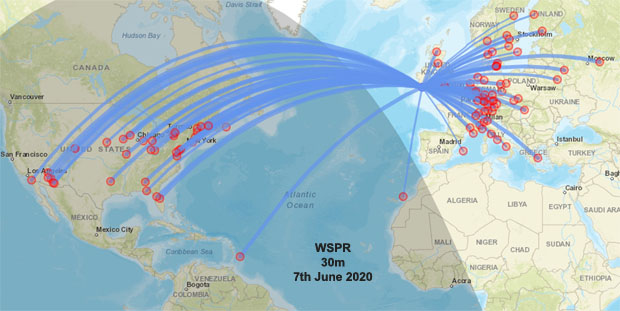Friday, June 5, 2020
Radio experiments for the Solar Eclipse on the 21st of June 2020
There is annular solar eclipse coming up on Sunday the 21st of June 2020 and the track is shown above. An annual eclipse is where the moon blocks most but not all of the light from the sun and in the centre of the path, the eclipse looks like a ring of fire.
Even though it's not a total eclipse, most of the radiation from the sun will be blocked and a group of scientists are looking for volunteers to monitor a Chinese time beacon on 10.000 MHz for any changes.
This citizen science project involves monitoring the time standard for extended periods of time using the FLDIGI software.
More info here... https://hamsci.org/june-2020-eclipse-festival-frequency-measurement
The eclipse also raises the possibility of individuals doing their own experiments. Is it possible to monitor say WSPR signals that cross the path or maybe monitoring the signal strength of a broadcast station?
It would probably involve doing some tests either side of the solar eclipse to make sure that the effects you saw were actually due to the eclipse.
The eclipse starts around 04:30 UTC and ends around 08:30 UTC. The maximum point will be over the north of India around 06:30 UTC.
Link...
1) Wikipedia link for the 2020 Solar Eclipse
Addendum...
As a pre-test, I am going to look at overnight WSPR reports on different bands to see if any might be suitable.
* * *
6th June 2020 - 40 metres : I left the radio on overnight and these are the stations heard on WSPR over several hours in the early hours of the 6th of June.
Nothing near the eclipse path so 40 metres is out.
* * *
7th June 2020 - 30 metres : Again, I listened overnight but this time on 30m.
Very similar to 40m.
* * *
10th June 2020 - 20 metres : This was more interesting as I heard VK3QN in Australia.
Even though the map shows the trace going over Asia to Australia (short path), there is also the possibility that the signal was long path i.e. It went down over South America and across the South Pacific to Australia.
Subscribe to:
Post Comments (Atom)




2 comments:
I definitely saw US stations vanish on WSPR (14MHz) during one of the recent eclipses, though I didn't do much analysis then. The near-total eclipse a couple of years ago over the UK also saw distinct signal drops at HF, easily detectable when using the UTwente SDR.
The problem this time is the dearth of WSPR stations in the right positions, but maybe ZS/FR/VK etc might fill the gap.
I would guess there's more hope of detecting changes using WSPR than listening to a single time beacon.
Yes John, I think WSPR is the way to go. The WSPRnet site will keep two weeks of records so perhaps it's just a case of leaving the radio monitoring a certain band overnight and then looking for a pattern later in the data.
Post a Comment